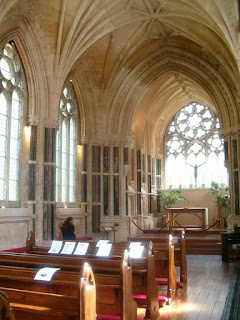Internal space has two interesting
properties: blocking light and admitting light. This is true for all sorts of
buildings. New trends in the challenge of creating sustainable architecture deal
with working out ideas about how they may admit light and block heat at the
same time, or harness the heat as a resource to create energy needed in the
building, for cooling in the summer, heating in the winter, and for artificial
lighting.
 |
| San Vitale, Ravenna |
But light –
admittance of light – has a symbolic and spiritual function in the sacred
architecture. We see different uses of it. In the early Byzantine churches
there were thick stone walls with smaller windows, often with a rounded arch on
top. The light would stream in through these openings, give the effect of spotlights,
but also leave other parts of the room in shadows.
There was also the
use of artificial light, candles or oil lamps, which create a soft, intimate
atmosphere. For instance in San Vitale in Ravenna, the contrast in light/shadow is captivating. In addition, the interior designs, murals, add to the meaning,
the interpretation of what is central, what meets us inside the thick walls. Intentional
mysteries are lingering in the light, dust, shaded areas, dark alcoves. This is
a sacred place, manifest during worship.
John, the apostle, testifies about Jesus, saying: “In him was life, and the life was the light of men. The light shines in the darkness, and the darkness has not overcome it.”
 |
| English Gothic chapel |
In the Gothic churches the admittance of light
was in focus, and large stained glass windows were inserted into the stone
structure. The internal space reflects a theology of stressing God’s greatness,
his light and grace. There is an open feel in the building, with tall walls,
high vaulted ceilings, with an upward drift. In order to create this
illuminated inner space, the building structure was laid on the outside, and we
see the support, particularly in the flying buttresses.
 |
| Fjågesund kyrkje |
How do
our parish churches play with light?
We have several churches in our parish, and
the priests take turn holding services in the different churches. Today we went
to a somewhat different church building, architecturally. It is inspired by the
traditional old stave churches of Norway and is a brown wooden building with
smaller windows admitting pockets of natural light. This church is located in
Fjågesund. It was built in 1915, high up on a hill. The wooden interior has carvings inspired by
old Norse folk traditions, in addition to the cross of St. Andrew. Vertical wood
panelling creates a cosy, but somewhat dark interior. There are two rows of
windows: larger ones on top and smaller ones in the lower level. One trefoil
shaped stained glass window above the altar symbolises the Holy Trinity, and
light streams in from this.
 |
| Fjågesund kyrkje, in servcie |
Jesus says: “You are the light of the world.”
The theme of light is closely connected to
truth and beauty. This connection is in turn fundamental in defining the moral
good. I sense an endless contemplation of light – a glimpse into eternal
perspectives.

Ingen kommentarer:
Legg inn en kommentar